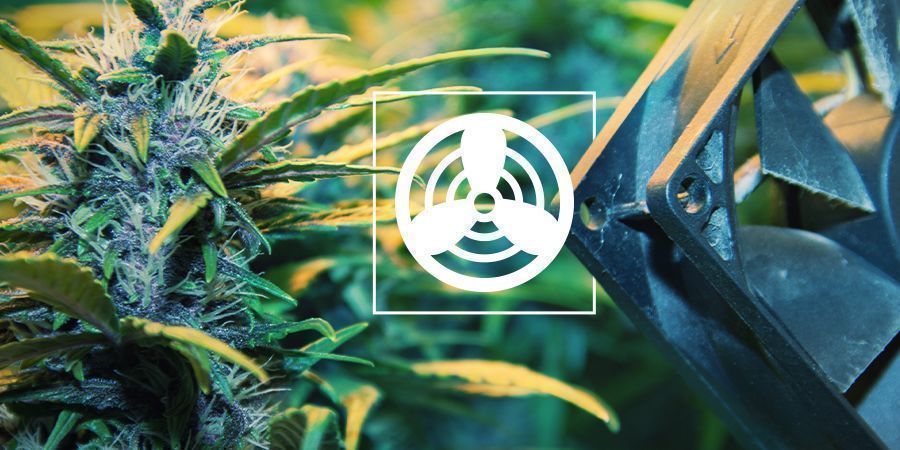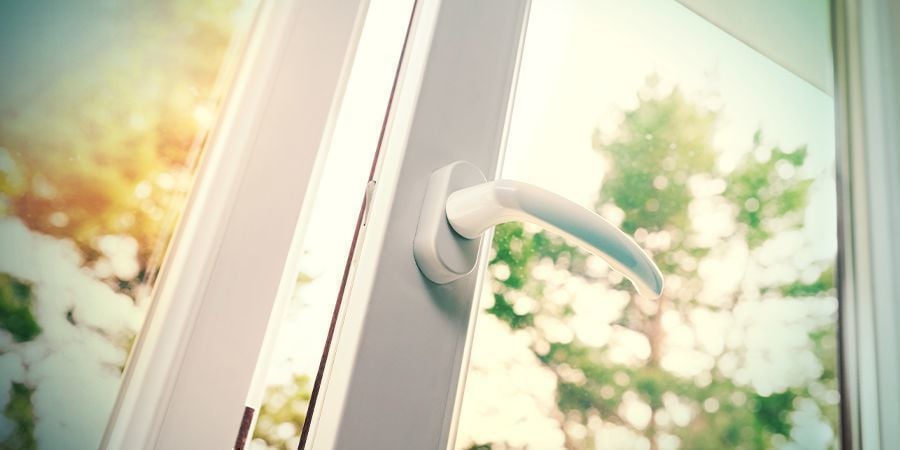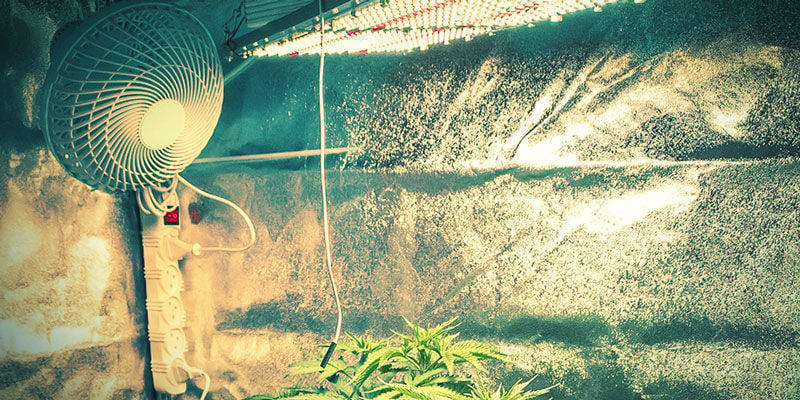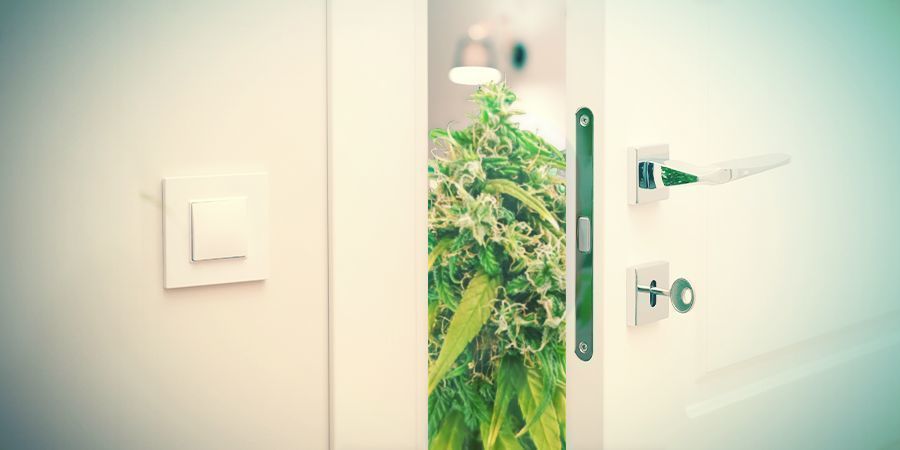Ventilation In The Cannabis Grow Space

Proper ventilation will help ensure a healthy and successful indoor grow. A constant supply of fresh air provides plants with adequate levels of CO₂ and keeps humidity in check so mould doesn't become an issue. Depending on the scale of your grow, simply opening a window may be good enough, while large-scale operations will inevitably require fans and ventilation hoods. Learn how to ventilate your grow space below.
Why ventilate?
Nearly all living things depend on air of good enough quality. For people, that means enough oxygen is in the air and that the air is not too polluted. For plants, and so too for cannabis, good air means sufficient carbon dioxide (CO₂) and little to zero pollution. Furthermore, relative humidity and temperature play large roles in plant growth.
Outdoor air contains about 0.03 to 0.04% CO₂. The quantity of carbon dioxide is also measured in parts per million (ppm), when 0.03% translates as 300ppm. There are differences in CO₂-requirements between different plants, but for cannabis specifically, raising the CO₂ level to about 1400 ppm can help to accelerate plant growth. Beware however, for with this the law of diminishing returns applies, so creating raised CO₂ levels has its limits.
Raising it to about 1400 ppm (0.14%) generally delivers good results: plants will grow faster. Above 1400 ppm, the effect of adding CO₂ tails off quickly. Not only for humans but also for plants, a high concentration of CO₂ is poisonous - for most plants a CO₂ concentration of 1800 ppm or more is fatal.
A simple method of guaranteeing the level of carbon dioxide is to ventilate the space. There needs to be enough ventilation that the plants have a constant supply of fresh air. If they’re being grown out in the open, then this is not something we have to worry about, there’s fresh air aplenty. If we switch to growing indoors, we need another way of providing this fresh air that contains both oxygen and CO₂ for our plants, such as carbon burners and ventilation.
A second and equally important reason for ventilation is the removal of heat. When the temperature gets too high, the growth of the plants is hindered. This applies not just to the temperature in the grow space, but also for the temperature of the plant itself. When the temperature of the plant is too high (we humans call it a fever), then the sap stream in the plant is reduced, which in turn leads to growth retardation.
There is no standard solution for air refreshment. The need for fresh air is to a large extent dependent on the volume of the grow space in cubic metres. In principle every 2-3 minutes the complete volume of the grow space must be refreshed.
Manual ventilation

With manual ventilation you can cover a space where a couple of plants are stood, where they have access to fresh air for a few hours a day. In order for this room to have the fresh air, all you need to do is leave a door or window open for a period of time. If you’re not certain you can always do the odour test: if you walk into the room and it smells stale, then you can be sure it is time to crack a window or two and refresh the air manually.
Electrical ventilation
This method of refreshing the air involves the use of an electrically powered gizmo ranging from the simple bathroom-style fan, up to industrial ventilators depending on the size of your space and number of plants.
Methods of electrical ventilation:
- A PC fan is suitable for small grow spaces, though if your lamps total more than 250 Watt you will need a different solution.
- A ventilation hood or extractor fan is suitable for large grow spaces.
- Tube ventilation is also suitable for large grow spaces.
WHAT ARE CFM AND CMM?
Cubic feet per minute (CFM) or cubic metres per minute (CMM) are imperial and metric terms, respectively, that describe the rate of the air exchange in a grow space.
Regular exchange of air in the grow-op helps regulate temperatures and ensures efficient gas exchange at the leaf stomata. In nature, this is taken care of by the breeze or by convection when the air is still. Indoors, air movement, ventilation, and exhausting are all supplied by the grower.
All cannabis grow spaces need to be ventilated and exhausted. The closed nature of a grow room or even a small tent requires the complete air volume to be exchanged every three minutes. This rate is the minimum needed to maintain good cannabis plant vigour.
CALCULATING VENTILATION NEEDS: THE MATH IS SIMPLE!

The total volume of air that needs to be exchanged is dependant on a number of factors common to all grows, small or large.
1. V: Volume of grow space
This is calculated by multiplying the width x length x height of the space.
2. E: Minimum volume exchanged
- The grow space volume needs to be exchanged every three minutes.
- Dividing the grow space volume by three gives the volume needed to be exhausted per minute.
- V/3 = E
3. L: Number and type of lights
HID lights generate heat, which needs to be considered when exhausting a grow. 5% extra volume needs to be exchanged for every ventilated HID light in the setup. 10-15% extra needs to be added for unventilated lights.
4. C: Carbon filter use
Carbon filters resist airflow and will require another 20% of the volume be moved.
5. G: CO₂ use
Using CO₂-enrichment to boost growth requires another 5% of volume exchanged.
6. A: Ambient air temperature
The warmer the climate, the more the air needs to be moved. Plants become vulnerable in warm and especially humid conditions. For hot and dry climates like southern Spain, add 25%. For hot and humid climates, add 40% because damp air is dangerous. Cannabis prefers a temperature range that doesn’t exceed 27°C. In very warm climates, inlet air conditioning systems may be needed to keep ambient temps friendly.
A SAMPLE GROW ROOM

Let's say we are using a 3m x 3m x 2.4m room as a grow space. It has two self-exhausting HID lights and two inline carbon filters. CO₂ is being used to maximise growth and the ambient air inlet temperature is below 27°C (so we don’t have to allow for temp).
1. First, we need to calculate the baseline air volume that needs to be exchanged.
V/3 = E
(3 x 3 x 2.4)/3 = 7.2CMM
Our example room needs to exhaust 7.2 cubic metres of air per minute for cannabis plants to be at their best.
2. Now, we need to compensate for the additional stresses placed on the system.
(L x 2)+(C x 2)+G+A x CMM = EXTRA
(10%+40%+5%+0%) x 7.2 = 3.96 additional CMM
Our example grow space will require a total minimum air exchange capacity of 11.16 CMM.
It is wise not to cut corners with airflow, ventilation, and exhausting a grow space. Air is elemental to good cannabis health. When in doubt, always err on the larger fan for the job. Fans can range in size from 100mm to 300mm, then onto commercial and industrial sizes.
Most common in cannabis grow rooms are 100mm and 150mm duct sizes with inline fans and filters to suit. Most tents will function brilliantly with 100mm diameter gear. Our example grow room will require 150mm diameter gear which will move in excess of our requirements.
When unsure, always scale up when it comes to airflow. Without fully understanding mechanical engineering, it is difficult to calculate for oddities in airflow like filters, length of duct runs, and eddying in duct bends. Opting for the larger alternative in duct and fan sizes ensures unseen problems don’t occur and adversely affect your grow.
INFLOW IS IMPORTANT TOO

The condition, quality, and volume of inlet air into a grow room is equally as important as the need for exhausting. Smaller open spaces using lower-wattage lighting will be able to exchange air simply by providing rigorous air circulation. A passive exhaust and inlet will provide enough air exchange for a small grow.
Larger and especially enclosed spaces with higher-wattage lights like grow tents and cupboards will need an air inlet. This can be an open window or door, but security usually prohibits such a casual approach. Inlet air should preferably come from a cooler and clean source like another room or under a house. Installing filtered ports in doors, walls, and windows guarantees fresh air (but can piss off landlords). Small spaces can simply provide an inlet vent with a grill or filter furthest away from the exhaust fan as practical.
With larger spaces, growers get better results when an inlet fan is used that equals the exchange rate of the exhaust setup. Placed as far from the exhaust fans as possible in the floor or lower wall is ideal. The further the fresh air needs to travel over your crop, the better. Ducted inlet fans can source air from wherever is convenient to the grow setup.
Inlet fans prevent negative pressures from building up in the grow room and putting stress on other systems. They also stop doors from slamming and things being blown off shelves when doors are opened and pressures equalise. Depending on your budget, louvred shutters or backdraft dampers can be installed. These will open and close when the exhaust fans turn on and off.
FANS ARE GOOD
The selection of fans on the market ranges widely in cost and functionality as well as lifetime and power efficiency. Using your newfound knowledge of air circulation for healthy marijuana, you will be able to confidently select a fan that will do the job you require with noiseless ease. Good air, water, and nutes means great buds. Here’s a handy tool for converting imperial to metric and back again, when shopping for fans.





 United States
United States











